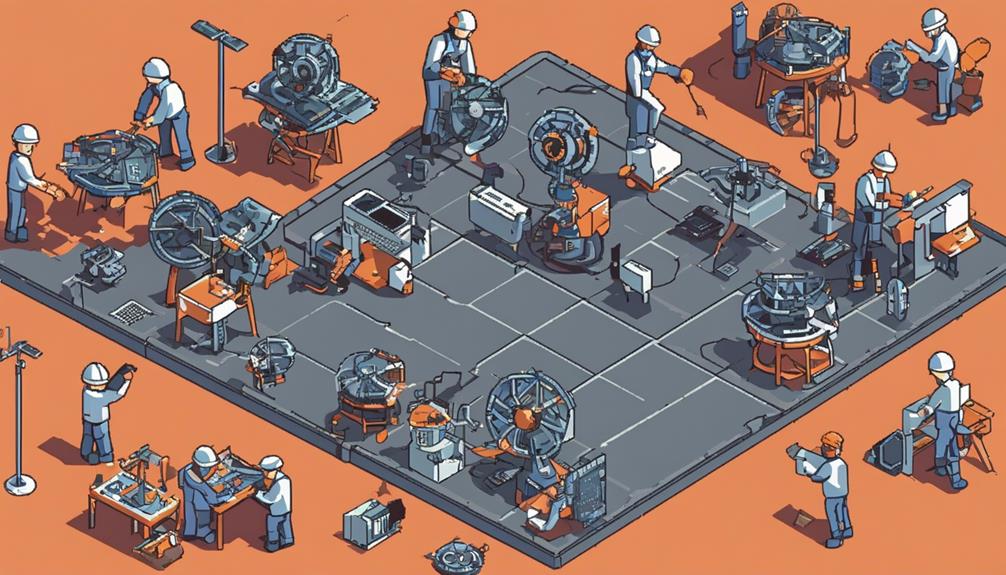The proliferation of satellite technologies has revolutionized communication, navigation, and Earth observation capabilities. However, with these advancements comes the pressing issue of managing electronic waste generated by satellite systems. The intricate components and materials used in satellites pose unique challenges for disposal and recycling. Exploring the complexities of e-waste from satellite technologies unveils a web of environmental implications and sustainability considerations that demand careful examination. As we delve into the realm of electronic waste from satellites, a deeper understanding of the consequences and potential solutions emerges, shedding light on the importance of responsible e-waste management in the space industry.
Key Takeaways
- Satellite production contributes to global e-waste.
- Sustainable disposal practices are vital.
- Recycling satellite electronics conserves resources.
- Extended producer responsibility programs aid e-waste mitigation.
The Impact of Satellite Production

The proliferation of satellite production in the aerospace industry significantly contributes to the mounting electronic waste dilemma as technological advancements and upgrades render satellite components obsolete, necessitating proper e-waste management strategies to mitigate environmental repercussions. The global impact of satellite production on electronic waste is substantial. As the demand for satellites increases worldwide for communication, Earth observation, navigation, and scientific research, the number of satellites being manufactured and launched rises correspondingly. This surge in satellite deployments leads to a parallel increase in electronic waste generated from outdated or malfunctioning satellite units.
Satellites are complex technological systems composed of various components like solar panels, antennas, and electronics that have limited operational lifespans. As newer, more advanced satellites are developed and launched, older satellites become obsolete, contributing to the electronic waste stream. In addition to satellites reaching the end of their service life, upgrades in technology and capabilities often necessitate the replacement of entire satellites, further exacerbating the issue of electronic waste.
Addressing the global electronic waste challenge stemming from satellite production requires satellite manufacturers to adopt sustainable practices throughout the satellite lifecycle. Implementing efficient e-waste management strategies is crucial to minimize the environmental impact of satellite production and disposal, promoting responsible and eco-friendly practices within the aerospace industry.
Operational Lifespan and Electronic Waste
Satellite technologies typically have an operational lifespan ranging from 5 to 15 years, after which they become part of the electronic waste stream. The disposal of decommissioned satellites poses challenges due to the increasing number of satellites reaching their end-of-life phase. Finding efficient waste management options for satellite electronic waste is crucial to prevent the accumulation of space debris and ensure sustainable practices in space technology.
Lifespan Impact
With varying operational lifespans, satellite technologies present a significant challenge in managing electronic waste accumulation in space.
- Short Lifespan: Some satellites have operational lifespans lasting only a few years, contributing significantly to space waste as they become defunct and add to the debris orbiting Earth.
- Impact on E-waste: Decommissioned satellites further exacerbate the growing e-waste issue in space, necessitating sustainable practices to address the environmental impact.
- Sustainable Development: Understanding the implications of operational lifespans on electronic waste generation is vital for the sustainable advancement of satellite technology. Efforts to extend the operational lifespans of satellites can help minimize the amount of e-waste produced in space, emphasizing the importance of proper disposal and recycling methods to mitigate environmental consequences.
Waste Management Options
Considering the limited operational lifespan of satellite technologies, effective waste management strategies are imperative to address the electronic waste generated from these systems. Satellites typically function for 5-15 years before contributing to the e-waste stream upon decommissioning. The disposal of satellite components, including solar panels, propulsion systems, and electronic parts, requires proper handling to minimize environmental impact. Sustainable practices and responsible end-of-life management are essential to mitigate the negative effects of satellite e-waste on the environment. Recycling plays a crucial role in this process, ensuring that valuable materials are recovered and reused. By implementing sound waste management options, the satellite industry can work towards reducing its overall electronic waste footprint and promoting a more sustainable approach to satellite technology disposal.
Decommissioning Challenges and E-Waste

The management of decommissioned space equipment presents formidable challenges in effectively handling the electronic waste generated from satellite technologies. E-waste from satellite technologies contributes to the growing waste stream and space trash concerns, necessitating careful consideration and innovative solutions to address these issues. Here are three key challenges related to decommissioning and e-waste from satellite technologies:
- Complex Waste Stream: Decommissioning satellites results in a complex waste stream comprising defunct satellites, spent rocket stages, solar panels, and assorted electronic components. Disposing of these items safely is crucial to prevent environmental harm and the proliferation of space debris.
- Specialized Materials: Satellite technologies incorporate specialized materials such as rare earth metals, composite materials, and toxic chemicals. Properly managing these materials during decommissioning is essential to minimize the environmental impact and ensure the safe disposal or recycling of satellite components.
- Regulatory Compliance: Decommissioning satellite technologies must adhere to stringent regulatory requirements to safeguard the environment and public health. Meeting these compliance standards while effectively managing electronic waste poses a significant challenge that necessitates careful planning and execution.
Addressing these challenges through sustainable decommissioning practices, efficient recycling methods, and responsible waste management strategies is imperative to mitigate the impact of e-waste from satellite technologies on both Earth and space environments.
Environmental Consequences of Satellite Technologies
Satellite technologies, while pivotal for modern communication and navigation systems, contribute significantly to environmental degradation. The disposal of satellite components, often containing hazardous materials like lead and mercury, can lead to soil and water contamination, affecting ecosystems. Furthermore, the accumulation of decommissioned satellites and space debris poses long-term risks to both the environment and human health.
Impact on Ecosystems
In the realm of satellite technologies, the impact on ecosystems manifests through the generation of electronic waste, specifically through the disposal of defunct satellites and their components.
Environmental Consequences on Ecosystems:
- E-waste from satellite technologies can release harmful compounds like lead and mercury into the environment, posing risks to ecosystems.
- Improper disposal of satellite electronic components can lead to contamination of groundwater and soil, affecting plant and animal life.
- Satellite technology advancements result in the continuous cycle of e-waste production, exacerbating environmental consequences on ecosystems.
Pollution and Waste
Amidst the realm of satellite technologies, the repercussions of pollution and waste management emerge as critical focal points requiring meticulous attention and strategic mitigation strategies. Satellite technologies contribute significantly to electronic waste (e-waste) accumulation, with decommissioned satellites and rocket components left in orbit posing environmental risks through potential collisions and debris generation. E-waste from satellite technologies contains hazardous materials like batteries, circuit boards, and metals, which can impact ecosystems if not properly managed. Moreover, space debris resulting from satellite technologies can contaminate Earth's atmosphere and oceans, adversely affecting marine life and biodiversity. Therefore, the proper disposal of satellite technology waste is essential to prevent pollution and minimize environmental harm, necessitating careful consideration and responsible management practices.
Recycling and Upcycling Satellite Electronics

Exploring the potential for recycling and upcycling electronic components from satellite technologies presents a sustainable approach to resource management in the space industry. Satellite electronics contain valuable materials like gold, silver, and copper that can be recycled and upcycled into new products. This process not only reduces the need for mining new resources but also helps in conserving raw materials, making it an environmentally friendly practice.
Key Points:
- Resource Conservation: Recycling satellite electronics is crucial for conserving valuable materials such as gold, silver, and copper. By extracting these materials from old satellite components, companies can reduce the environmental impact of mining and contribute to a more sustainable resource management system.
- Environmental Protection: Proper disposal and recycling of satellite electronics prevent environmental pollution from hazardous materials. By ensuring that these electronic components are recycled responsibly, the space industry can minimize its carbon footprint and mitigate the negative effects of e-waste on the environment.
- Innovation in Sustainability: Satellite technology companies are increasingly exploring innovative ways to repurpose old satellite components for new missions. Upcycling satellite electronics into new satellite technologies not only extends the lifespan of these components but also fosters a culture of sustainability within the industry, driving progress towards a greener future.
Future Strategies for E-Waste Mitigation
Efforts to mitigate electronic waste in the satellite technology sector are increasingly focusing on implementing extended producer responsibility programs and promoting sustainable designs and materials to reduce future e-waste generation. By shifting the burden of recycling electronic waste from consumers to manufacturers through extended producer responsibility programs, the satellite industry can take significant steps towards reducing its environmental impact. Additionally, encouraging the development of sustainable designs and materials in satellite technologies can help in minimizing e-waste generation in the long term. Promoting the reuse and refurbishment of satellite components is another effective strategy to extend their service life and decrease electronic waste disposal.
| Strategies for E-Waste Mitigation | Description |
|---|---|
| Extended Producer Responsibility Programs | Shift recycling burden from consumers to manufacturers. |
| Sustainable Designs and Materials | Develop eco-friendly solutions to reduce e-waste. |
| Reuse and Refurbishment | Extend service life of satellite components. |
| Legislation Compliance | Support laws for proper e-waste disposal. |
| Research and Development | Invest in eco-friendly materials and recycling processes. |
Frequently Asked Questions
What Is the Waste That Contains Electronic Devices?
Electronic waste, commonly referred to as e-waste, encompasses discarded electronic devices like computers, smartphones, and appliances. This waste stream poses significant environmental impact concerns due to the presence of hazardous materials. Recycling initiatives are crucial to divert e-waste from landfills, recover valuable resources, and reduce pollution. Proper management of e-waste is essential to promote sustainability and minimize the negative effects on ecosystems and human health.
What Are 4 Examples of E-Waste?
When it comes to electronic waste, four common examples include discarded smartphones, obsolete laptops, outdated televisions, and non-functional printers. Recycling solutions and disposal methods are crucial in managing this growing issue. Global regulations play a key role in ensuring proper handling of e-waste to mitigate environmental impacts. By adhering to established protocols and implementing sustainable practices, we can work towards a more sustainable future for electronic waste management.
What Is the Cause of Electronic Waste?
Electronic waste is primarily caused by the fast pace of technological advancements, leading to frequent upgrades and replacements. Obsolescence due to evolving standards forces the disposal of still-functional equipment. Damage from various factors like space debris or malfunctions can render devices inoperable, adding to waste. Limited repair options for complex devices also contribute. Recycling solutions are crucial to mitigate the environmental impact of this growing electronic waste.
Which Technology Is Used in E-Waste Management?
Various technologies are utilized in e-waste management to promote recycling methods and sustainability practices. These include pyrolysis, shredding, smelting, advanced sorting systems like optical scanners and magnetic separators, and chemical processes such as leaching and solvent extraction. Additionally, incineration with energy recovery is employed for non-recyclable e-waste disposal while generating electricity. Refurbishing and reusing electronic components also play a crucial role in sustainable e-waste management.
